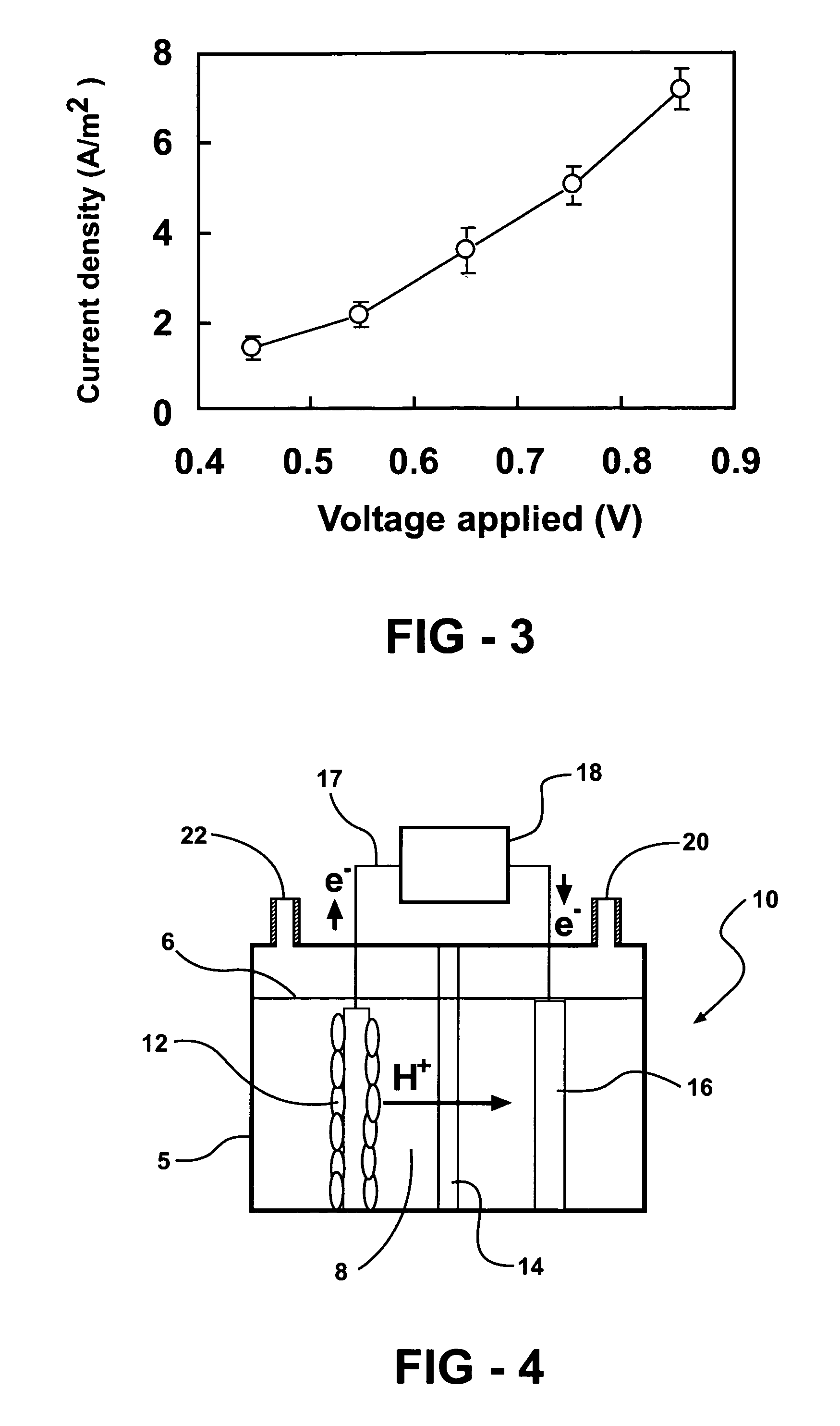Bio-electrochemically assisted microbial reactor that generates hydrogen gas and methods of generating hydrogen gas
a microbial reactor and bio-electrochemical technology, applied in the field of bio-electrochemically assisted microbial reactor systems and processes for producing hydrogen gas, can solve the problem of low yield and achieve the effect of increasing potential
- Summary
- Abstract
- Description
- Claims
- Application Information
AI Technical Summary
Benefits of technology
Problems solved by technology
Method used
Image
Examples
example 1
[0118]Exemplary hydrogen-generating reactors are constructed in this example. Exemplary reactors described in this example are two-chamber MFCs with the anode and cathode separated by a proton exchange membrane (PEM; NAFION™ 117) (FIG. 4). The anode electrodes are plain carbon cloth and the cathode electrodes are made of carbon paper containing 0.5 mg-Pt / cm2.
[0119]A first exemplary reactor system is a two-bottle reactor (310 mL-capacity each; Wheaton™ Scientific) with a PEM held by a clamp in a tube separating the chambers, with electrodes spaced 15 cm apart. Instead of sparging the cathode chamber with air, the chamber is sealed and analyzed periodically for hydrogen gas production. Each electrode is 12 cm2 and the proton exchange membrane is 3.5 cm2, and the bottles are filled to 200 mL.
[0120]A second exemplary reactor is a tubular shaped reactor. This reactor is converted into a two-chamber system by inserting a PEM into the middle of a 4-cm long cylindrical chamber (3-cm in diam...
example 2
[0125]Measurements of current density are made using a reactor as described in Example 1. FIG. 1 shows increased current density (CD) and anode potential (AP) with the applied voltage in an inventive hydrogen generating system described in Example 1. Error bars ±S.D. are based on averages measured during stable conditions in three separate batch experiments. Current density increased with the applied voltage from 0.15 A / m2 (250 mV) to 0.88 A / m2 (850 mV) (FIG. 1). The anode potential decreased with the voltage added from −291 mV (250 mV) to −275 mV (850 mV) (FIG. 2). Over 95% of the acetate is typically degraded by the end of a batch cycle (when the reactor is re-filled with fresh medium). This reactor is run for over four months, under various operating conditions, in order to demonstrate that hydrogen generation is stable in this type of reactor.
example 3
[0126]Measurements of hydrogen recovery and Coulombic efficiency as a function of applied voltage are made using a reactor as described in Example 1. FIG. 2 shows Hydrogen recovery and Coulombic efficiency (CE) as a function of the applied voltage in a two-chambered hydrogen generating system described in Example 1. Error bars ±S.D. are based on averages measured during stable conditions in three separate batch experiments. The recovery of electrons as hydrogen is over 90% (FIG. 2). The Coulombic efficiency, defined as the recovery of total electrons in acetate as current (eq. 1), ranged from 60-78% depending on the applied voltage (FIG. 2). This range in Coulombic efficiency is similar to that obtained in some aerobic MFCs (21, 22). Assuming a maximum possible production of 4 mol-H2 / mol-acetate, a 78% Coulombic efficiency, and 92% current recovery as hydrogen, the overall hydrogen yield is 2.9 mol-H2 / mol-acetate. The recovery of electrons is affected by many factors, including biom...
PUM
| Property | Measurement | Unit |
|---|---|---|
| distance | aaaaa | aaaaa |
| surface area | aaaaa | aaaaa |
| voltage | aaaaa | aaaaa |
Abstract
Description
Claims
Application Information
 Login to View More
Login to View More - R&D
- Intellectual Property
- Life Sciences
- Materials
- Tech Scout
- Unparalleled Data Quality
- Higher Quality Content
- 60% Fewer Hallucinations
Browse by: Latest US Patents, China's latest patents, Technical Efficacy Thesaurus, Application Domain, Technology Topic, Popular Technical Reports.
© 2025 PatSnap. All rights reserved.Legal|Privacy policy|Modern Slavery Act Transparency Statement|Sitemap|About US| Contact US: help@patsnap.com



